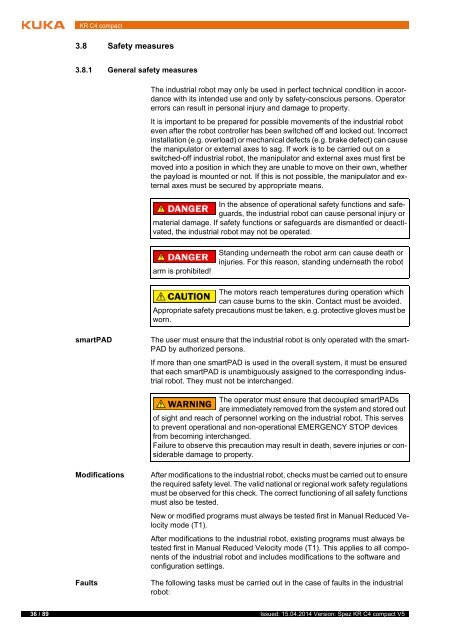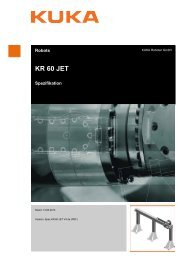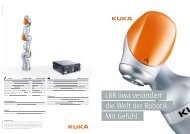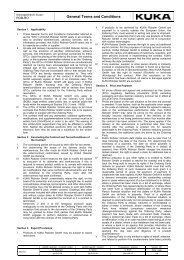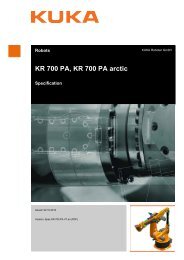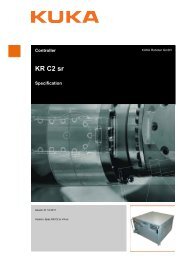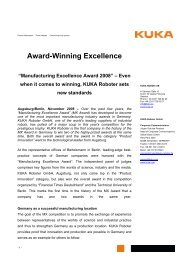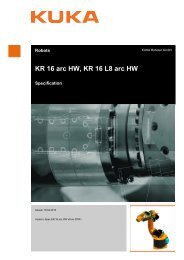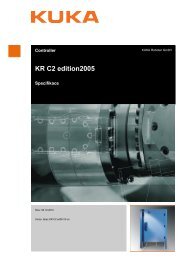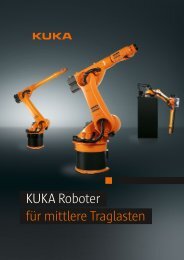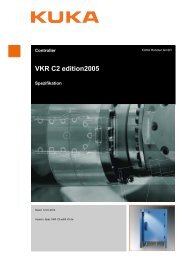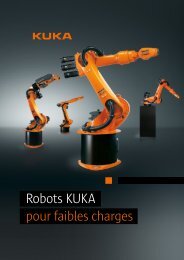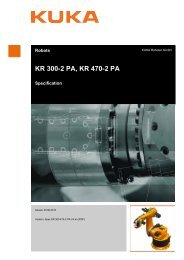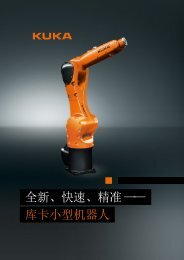KR C4 compact - KUKA Robotics
KR C4 compact - KUKA Robotics
KR C4 compact - KUKA Robotics
You also want an ePaper? Increase the reach of your titles
YUMPU automatically turns print PDFs into web optimized ePapers that Google loves.
<strong>KR</strong> <strong>C4</strong> <strong>compact</strong><br />
3.8 Safety measures<br />
3.8.1 General safety measures<br />
The industrial robot may only be used in perfect technical condition in accordance<br />
with its intended use and only by safety-conscious persons. Operator<br />
errors can result in personal injury and damage to property.<br />
It is important to be prepared for possible movements of the industrial robot<br />
even after the robot controller has been switched off and locked out. Incorrect<br />
installation (e.g. overload) or mechanical defects (e.g. brake defect) can cause<br />
the manipulator or external axes to sag. If work is to be carried out on a<br />
switched-off industrial robot, the manipulator and external axes must first be<br />
moved into a position in which they are unable to move on their own, whether<br />
the payload is mounted or not. If this is not possible, the manipulator and external<br />
axes must be secured by appropriate means.<br />
In the absence of operational safety functions and safeguards,<br />
the industrial robot can cause personal injury or<br />
material damage. If safety functions or safeguards are dismantled or deactivated,<br />
the industrial robot may not be operated.<br />
arm is prohibited!<br />
Standing underneath the robot arm can cause death or<br />
injuries. For this reason, standing underneath the robot<br />
The motors reach temperatures during operation which<br />
can cause burns to the skin. Contact must be avoided.<br />
Appropriate safety precautions must be taken, e.g. protective gloves must be<br />
worn.<br />
smartPAD<br />
The user must ensure that the industrial robot is only operated with the smart-<br />
PAD by authorized persons.<br />
If more than one smartPAD is used in the overall system, it must be ensured<br />
that each smartPAD is unambiguously assigned to the corresponding industrial<br />
robot. They must not be interchanged.<br />
The operator must ensure that decoupled smartPADs<br />
are immediately removed from the system and stored out<br />
of sight and reach of personnel working on the industrial robot. This serves<br />
to prevent operational and non-operational EMERGENCY STOP devices<br />
from becoming interchanged.<br />
Failure to observe this precaution may result in death, severe injuries or considerable<br />
damage to property.<br />
Modifications<br />
Faults<br />
After modifications to the industrial robot, checks must be carried out to ensure<br />
the required safety level. The valid national or regional work safety regulations<br />
must be observed for this check. The correct functioning of all safety functions<br />
must also be tested.<br />
New or modified programs must always be tested first in Manual Reduced Velocity<br />
mode (T1).<br />
After modifications to the industrial robot, existing programs must always be<br />
tested first in Manual Reduced Velocity mode (T1). This applies to all components<br />
of the industrial robot and includes modifications to the software and<br />
configuration settings.<br />
The following tasks must be carried out in the case of faults in the industrial<br />
robot:<br />
36 / 89 Issued: 15.04.2014 Version: Spez <strong>KR</strong> <strong>C4</strong> <strong>compact</strong> V5


